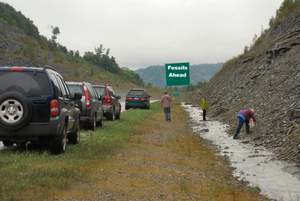
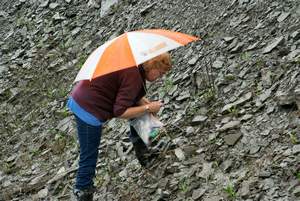
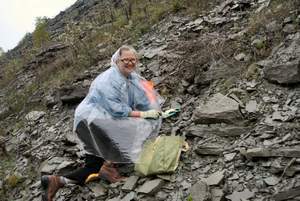
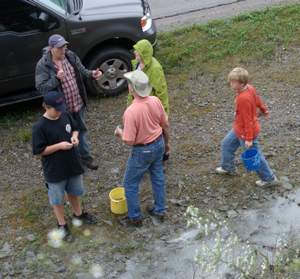
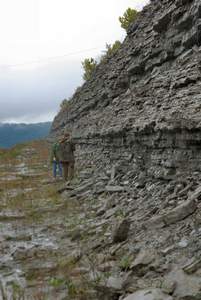
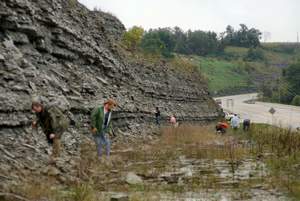
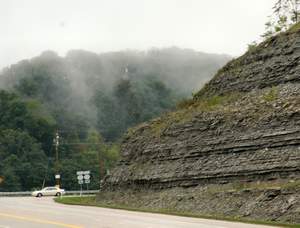
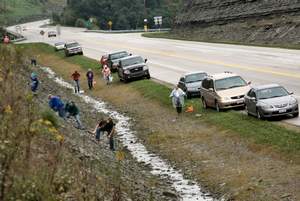
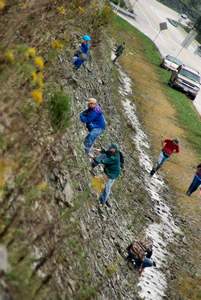
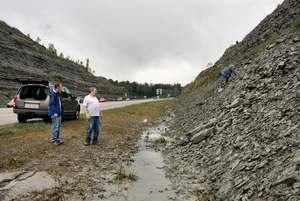
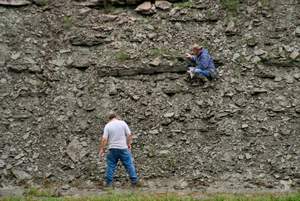
It had rained for days before this field trip. It rained all night before the field trip. It was raining that morning. But everyone knows the Dry Dredgers field trips are held rain or shine. It doesn't mean members MUST attend, but they may. And they came to this one. When we visited this site in 2005, it was raining too, but good fossils were found anyway. So this time, we had a good turnout of Dry Dredgers eager to find good fossils. And no one was disappointed. As you will see, some GREAT fossils were found. We arrived at 11 am. It stopped drizzling by noon.
The site exposes much of the Kope and Fairview formation. Since we pulled over in the heart of the Fairview formation and there were plenty of fossils there, most stayed in these layers.
Here are some photos from our nice outing. It was a lot of fun.
Fossils Found That Day
The best find was this excellent Isotelus trilobite. Most of the exoskeleton was missing, but some parts remained and the rest was internal mold. Congratulations!
Another articulated Isotelus was found, but less
of it remained. (below 1 pic).
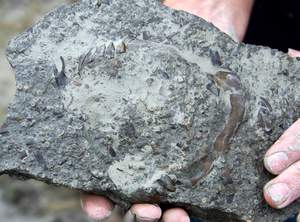
Here's another Isotelus. The pygidium is exposed and some of the thorax may be under the matrix.
Another Isotelus remains only as a free check.
You can see the eye in this picture. You can also see a cephalopod.
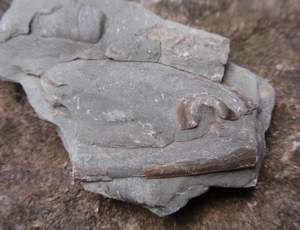
Another Isotelus find consisted of broken
segments that may fit back together.
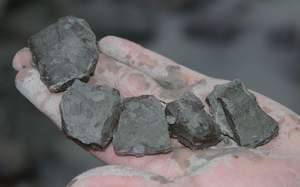
Most Isotelus parts were found loose on the
surface of rocks.
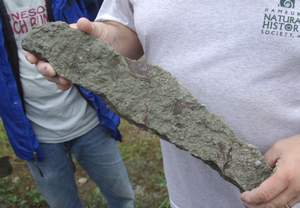
The next best find was what looks like a rolled up sea star
fossil. (next 2 pics)
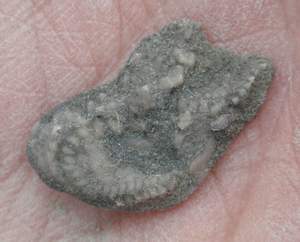
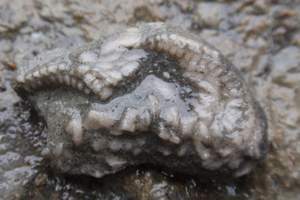
Lots of calyxes of the Crinoid,
Ectenocrinus
simplex were found. There were 3 calyxes in the next picture.
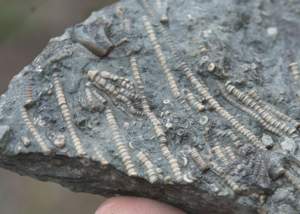
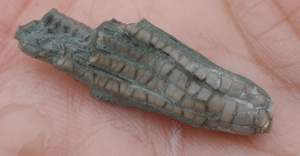
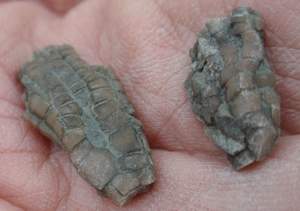
Here's an interesting crinoid fossil. It falsely looks as if could
be a Radicular cirri,
a type of holdfast where root-like extremities hold the crinoid to the muddy
ocean bottom. However, the supposed "root" structure, as you can see
in this photo, isn't connected to the stem. It is just arms from another crinoid
below the stem.
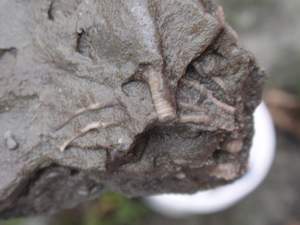
Another interesting crinoid holdfast that was found was this
coiled crinoid base. In this case, the crinoid
wrapped around another crinoid or other object to hold on and grow.
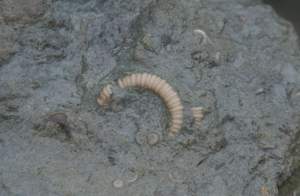
Quite a few "log jams" were also found. This is a dense population of articulated crinoid stems.
Cephalopods Found
We all found lots of nice specimens of straight-shelled
Nautiloid Cephalopods. What was nice about the combination of this particular
site and the recent rain, the Cephalopods were light brown in color, making them
easy to spot as you walk along the gray shale. The brown coloring is from the
calcite that fills the cavities of the chambers and also replace some of the
shell.
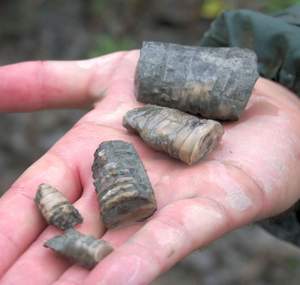
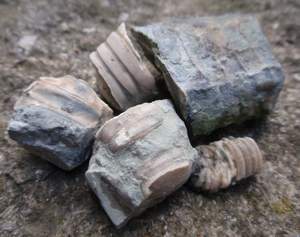
Notice that when you look at the ends of these Cephalopods,
you can see the tube of the Siphuncle running down the center of one of the
shell. Usually, one side is filled in with sediment and the other by calcite.
You can see this in the next two photos.
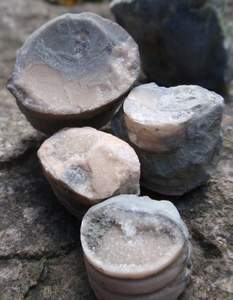
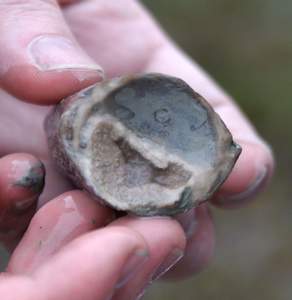
When looking at these Nautiloid Cephalopod fossils, look for epizoans (attached animals). These next 3 pictures show that the Cephalopod had been encrusted while alive with the bryozoan Spatiopora. The elongated monticules align with the direction of travel, suggesting the bryozoan was hanging on while the Cephalopod was swimming.
Do you see another epizoan on the above Cephalopod? Those tiny
black "tar spots" growing on the surface of the bryozoan growing on
the Cephalopod is Sphenothallus,
a type of worm holdfast. This is the first time I know I've seen Sphenothallus
on Spatiopora. Nice! I wonder if this was while the Cephalopod was
alive?!
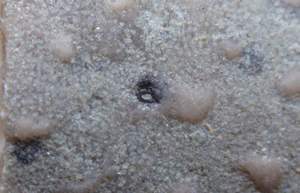
This next Cephalopod is interesting because of the way the
chambers made curved impressions on the surface of this fossil.
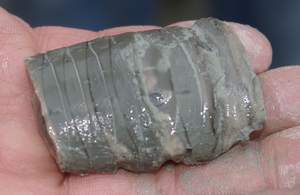
Many of the Cephalopods were found in matrix, such as the ones
in the next two pictures. They also stood out due to their light brown color.
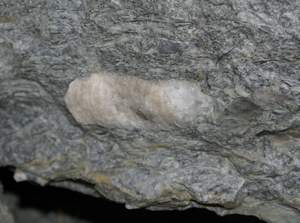
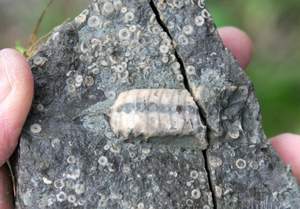
Some of the Cephalopods were found as broken fragments. This
one provided a cross-section of the chambers filled with Calcite.
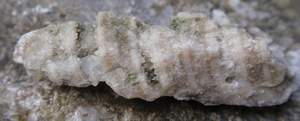
Pelecypods (clams) Found
Many of the bivalves found had a black residue on the surface.
This is from the original clam shell and can reveal microstructure from the
valve.
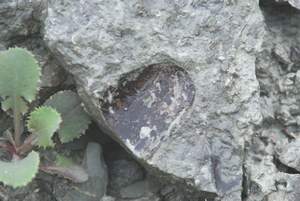
Here's a great clam find. This Dry Dredger broke open a rock
and found a complete clam. One side shows the external mold and the other side
shows the internal mold of the same clam.
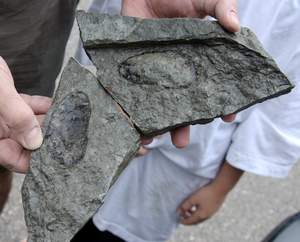
Bryozoans Found
As is true for all Cincinnatian fossil sites, this site was loaded with bryozoan colonies.
Here are some nice specimens of the bryozoan Constellaria.
The monticules are star shaped, thus the name.
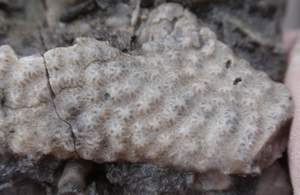
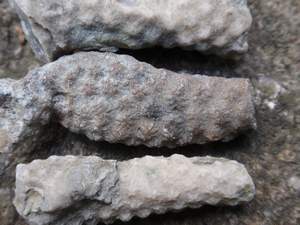
The Constellaria is a branching (ramose) bryozoan. Here's a
well articulated specimen to prove it.

Other types of branching bryozoans littered the ground and were found attached to rock.
These next two specimens resemble the holdfasts of crinoids.
But they are actually bryozoans.
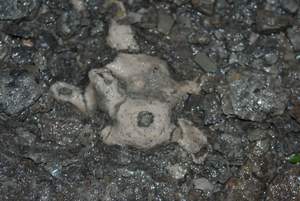
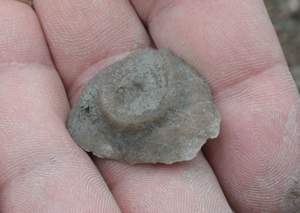
A few of the bryozoan fragments had a strange red coloration.
I think the red color is living algae, but I'm not certain.
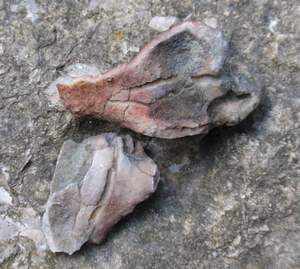
This light brown specimen is a split-open fragment of a
massive bryozoan on a fragment of a slab.
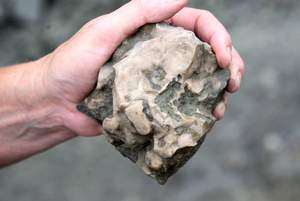
Here's a group shot of the bryozoans I took home that day.

Ichnofossils (Trace Fossils) Found
This rock has all kinds of trace fossils on it. Some of the
straight lines look like worm traces. But the double-node trace near the bottom
of the slab looks more like a trilobite trace to me.
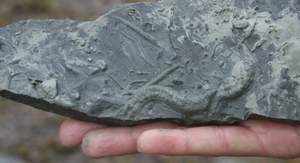
This next trace looks like a multiple Rusophycus
(trilobite burrow). I'm not sure it really ism though. It could be a worm trace.
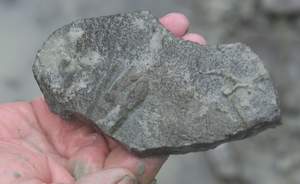
Gastropods (snails) Found
Quite a few internal molds of snails were found. Here are two
on the surface of a rock. They are probably either Paupospira or Lophospira.

At least one Bellerophontid was found. This is a
variety of Monoplacophoran. This is a snail-like mollusk that coils in on
itself and has an opening that bells out.
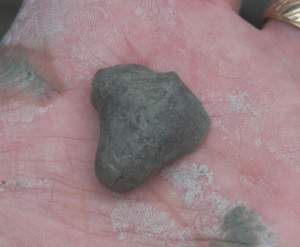
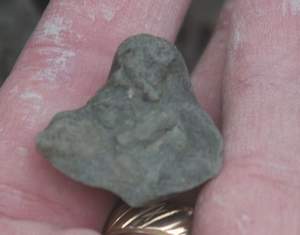
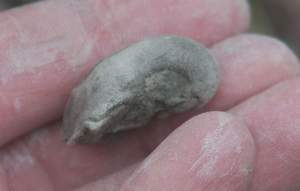
It was also a good site for finding lots of Cyclonema,
which is one of the few snail varieties in our area that have the external
features of the shell preserved.
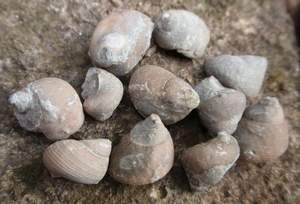
Brachiopods Found
This site exposes a layer of the articulate brachiopod Strophomena, which is found abundantly in
the Richmondian formations. In this case, we are in the Fairview formation and
the Strophomena are limited to this layer.
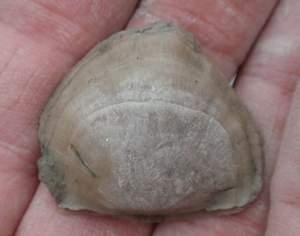
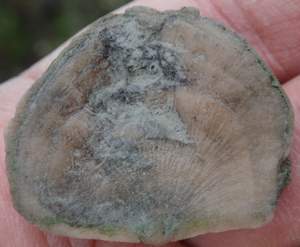
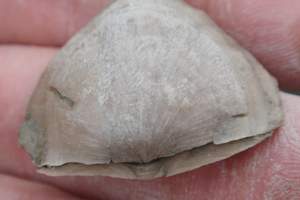
Here's a photo of the layer in situ. It's chunk-full of
Strophomena.
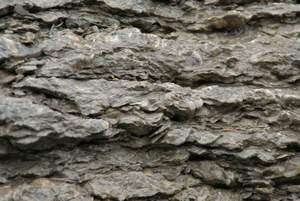
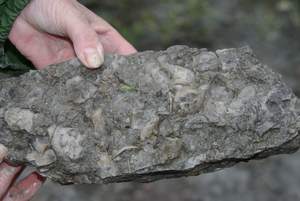
I found an example of a Strophomena on the surface of a rock
that shows the muscle scars that are diagnostic of the species. Notice also the
unusual white coloring. These Strophomena are normally a lighter shade of brown
than the other brachiopods. But it seems the minerals in this particular rock
have colored all the fossils a much lighter shade.
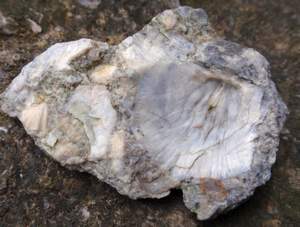
Another kind of brachiopod that has very light coloration is
the inarticulate brachiopod, Trematis
millepunctata. You can identify this type of brachiopod by the tiny
bumps that seem to puncture holes in the whitish surface. They are barely
visible in this specimen (below).
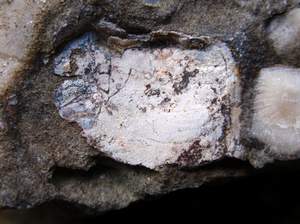
One member found a pocket of what I think are juvenile Hebertella.
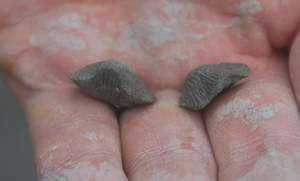
Some Vinlandostrophia
were also found. The specimen below seems to resemble Plectorthis on one side (first pic) but
when turned over (second pic), you can see that it's really a Vinlandostrophia. I'm
not sure which species it is.
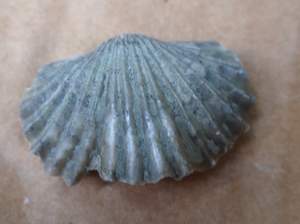
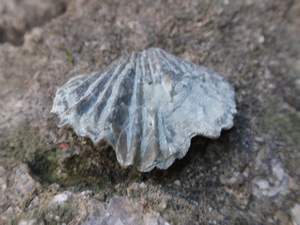
That's all there is for this field trip. It was worth going out there in the rain.
Now join us for our October 2009 field trip to the Oakes Quarry Park near Dayton, Ohio.
See some of our previous trips to this site.
March, 2008
September 2005
April 2005
Sept. 2003
Back to Field Trip Photo Index
Return to Dry Dredgers Home Page
The Dry Dredgers and individual contributors reserve the rights to all information, images, and content presented here. Permission to reproduce in any fashion, must be requested in writing to admin@drydredgers.org .